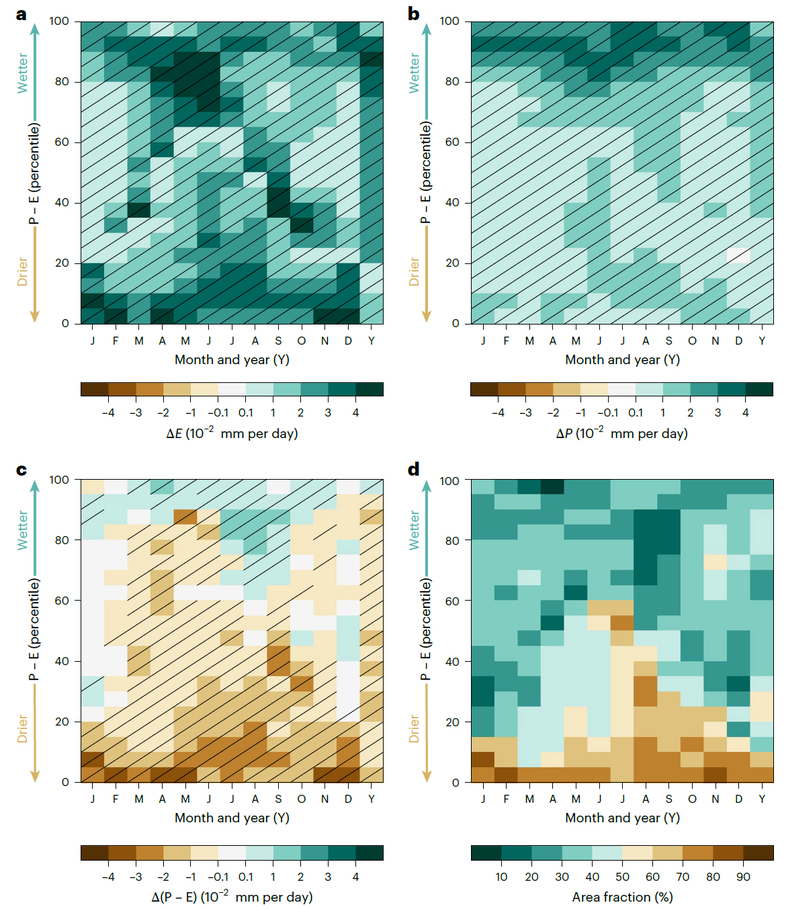Forest cover changes can influence energy and water exchanges between the land and atmosphere by altering surface properties (such as albedo and leaf area), which in turn impact precipitation and land water cycles. On the one hand, afforestation can increase surface evapotranspiration (E), intensifying land water loss; on the other hand, evaporated moisture can lead to precipitation (P) in local and downwind areas through moisture recycling, thereby compensating for water loss due to evapotranspiration. Recent studies have indicated that, when considering precipitation feedback, the impacts of afforestation on land water availability (P-E) exhibit significant spatial heterogeneity, suggesting that increases (decreases) in P-E due to afforestation are beneficial (detrimental) to land water resources. However, these studies focused primarily on the impacts of afforestation on P-E while overlooking seasonal and spatial variations in P-E itself. Therefore, ignoring temporal and spatial variations in P-E may lead to the underestimation of potential hydrological risks.
Assistant Professor Jun Ge from the School of Atmospheric Sciences and Professor Jiangfeng Wei from Nanjing University of Information Science and Technology investigated seasonal and spatial variations in P-E and its response to global restoration on the basis of satellite data and moisture tracking data. From a temporal perspective, afforestation leads to increases in P-E during the wet season (the season with the highest P-E) in 66% of the land area and decreases in P-E during the dry season (the season with the lowest P-E) in 54% of the land area (Figure 1). Consequently, afforestation results in greater seasonality of P-E in 64% of the land area, indicating that the wet season gets wetter and the dry season gets drier. Furthermore, increases in wet season P-E are more prevalent in humid areas (72%), whereas decreases in dry season P-E are more common in arid areas (63%).

Figure 1. (a) Seasonal variations in P-E and its response to afforestation at a grid point (6° N, 72° W). Impacts of afforestation on (b) the seasonality of P-E, (c) the wet season P-E, and (d) the dry season P-E. (e) Combined impacts of afforestation on the wet and dry seasons P-E.
From a spatial perspective, afforestation-driven increases in evapotranspiration are greater in drier areas (i.e., those with lower P-E) (Figure 2). This is because, compared with grasslands or croplands, forests have deeper roots that can access deeper soil moisture to maintain higher transpiration. However, the subsequent impact on precipitation is less pronounced in drier areas. This is because it is more difficult for drier areas to produce enough convective available potential energy to trigger local P simply by increasing E, and evaporated water is instead advected away. As a result, afforestation leads to decreasing P-E in drier areas while increasing P-E in wetter areas, resulting in wet areas getting wetter but dry areas getting drier.

Figure 2. Impacts of afforestation on (a) evapotranspiration, (b) precipitation, and (c) P-E binned as a function of P-E. (d) Proportion of areas where afforestation leads to a decrease in P-E binned as a function of P-E.
Further analysis at the national scale indicates that the moisture evaporated from afforestation can lead to cross-border transport between countries under the influence of atmospheric circulation, resulting in divergent precipitation and P-E changes across different countries (Figure 3). Afforestation can cause decreasing P-E in some countries/regions, including Africa, West Asia, Central Asia, the United States, Mexico, and Australia. In particular, Africa, West Asia, and Central Asia, which have relatively limited water resources per capita, may face exacerbated water resource crises and conflicts due to the decline in P-E caused by afforestation. Conversely, afforestation can also lead to increasing P-E in some countries, such as Canada, Russia, Indonesia, and the Democratic Republic of the Congo, most of which possess abundant water resources per capita. Therefore, afforestation tends to intensify the intercountry inequality in water resources per capita.

Figure 3. Impact of afforestation on P-E in different countries.
This study further confirms the necessity of considering precipitation feedback when assessing the hydrological effects of afforestation. Moreover, the inherent temporal and spatial variations in water availability must also be considered. Given the divergent impacts of afforestation on water resources across countries, this study calls for enhanced international cooperation to improve water resource management in response to the potential hydrological consequences of large-scale afforestation. Finally, considering that afforestation is a crucial approach for achieving carbon neutrality and mitigating global warming, fully accounting for the hydrological effects of large-scale afforestation in the future is essential to avoid negative impacts on water resources.
The study titled “Spatiotemporal inequality in land water availability amplified by global tree restoration” was published online in Nature Water on August 21, 2024. Dr. Beilei Zan from Nanjing University of Information Science and Technology and Assistant Professor Jun Ge from the School of Atmospheric Sciences, Nanjing University, are co-first authors of the paper. Assistant Professor Jun Ge and Professor Jiangfeng Wei from Nanjing University of Information Science and Technology are co-corresponding authors. The collaborative authors include Dr. Mengyuan Mu from the University of New South Wales, Professor Qiaohong Sun from Nanjing University of Information Science and Technology, and Xing Luo, a master student graduating from the School of Atmospheric Sciences, Nanjing University, in 2024. This work is supported by the Natural Science Foundation of China (42375115 and 42105023), the Fundamental Research Funds for the Central Universities (2024300330) and the Jiangsu Collaborative Innovation Center of Climate Change.
Reference:
Zan, B. L., Ge, J., Mu, M. Y., Sun, Q. H., Luo, X. and Wei, J. F. Spatiotemporal inequality in land water availability amplified by global tree restoration. Nature Water (2024). https://doi.org/10.1038/s44221-024-00296-5.
